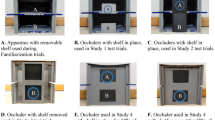Abstract
The nonadjacent double invisible displacement task has been used to test for the ability of different species to mentally represent the unperceived trajectory of an object. The task typically requires three occluders/boxes in a linear array and involves hiding an object in one of two nonadjacent boxes visited in succession. Previous research indicates that 19-, 26-, and 30-month-old children and various nonhuman species cannot solve these displacements. It has been hypothesized that this is because individuals are unable to inhibit searching in the unbaited center box that was never visited by the experimenter. It has been suggested that presenting the task in a large-scale locomotor space might allow individuals to overcome this inhibition problem. In the present study, we tested orangutans on adjacent and nonadjacent double invisible displacements with the traditional setup (experiment 1) and in locomotor space with boxes placed 1.22 m apart (experiment 2). In both experiments, subjects were able to solve adjacent, but not nonadjacent, trials. The failure on nonadjacent trials appeared to be because of an inability to inhibit sequential search on the second choice as well as because of a large number of first-choice errors (directly choosing an incorrect box). The current results support previous findings that orangutans exhibit some constraints when representing the invisible trajectory of objects.



Similar content being viewed by others
References
Albiach-Serrano A, Call J, Barth J (2010) Great apes track hidden objects after changes in the objects’ position and in subject’s orientation. Am J Primatol 72:349–359
Barth J, Call J (2006) Tracking the displacement of objects: a series of tasks with great apes (Pan troglodytes, Pan paniscus, Gorilla gorilla, and Pongo pygmaeus) and young children (Homo sapiens). J Exp Psychol Anim Behav Process 32(3):239–252
Call J (2001) Object permanence in orangutans (Pongo pygmaeus), chimpanzees (Pan troglodytes), and children (Homo sapiens). J Comp Psychol 115:159–171
Collier-Baker E, Suddendorf T (2006) Do chimpanzees (Pan troglodytes) and 2-year-old children (Homo sapiens) understand double invisible displacement? J Comp Psychol 120(2):89–97
Collier-Baker E, Davis JM, Suddendorf T (2004) Do dogs (Canis familiaris) understand invisible displacement? J Comp Psychol 118(4):421–433
Collier-Baker E, Davis JM, Nielsen M, Suddendorf T (2006) Do chimpanzees (Pan troglodytes) understand single invisible displacement? Anim Cogn 9:55–61
de Blois ST, Novak MA (1994) Object permanence in rhesus monkeys (Macaca mulatta). J Comp Psychol 108(4):318–327
de Blois ST, Novak MA, Bond M (1998) Object permanence in orangutans (Pongo pygmaeus) and squirrel monkeys (Saimiri sciureus). J Comp Psychol 112:137–152
Deppe AM, Wright PC, Szelistowski WA (2009) Object permanence in lemurs. Anim Cogn 12(2):381–388
Dore FY, Dumas C (1987) Psychology of animal cognition: piagetian studies. Psychol Bull 102:219–233
Dore FY, Goulet S (1998) The comparative analysis of object knowledge. In: Langer J, Killen M (eds) Piaget, evolution, and development. Erlbaum, New Jersey, pp 55–72
Fedor A, Skollar G, Szerencsy N, Ujhelyi M (2008) Object permanence tests on gibbons (Hylobatidae). J Comp Psychol 122(4):403–417
Filion CM, Washburn DA, Gulledge JP (1996) Can monkeys (Macaca mulatta) represent invisible displacement? J Comp Psychol 110:386–395
Fiset S, LeBlanc V (2007) Invisible displacement understanding in domestic dogs (Canis familiaris): the role of visual cues in search behavior. Anim Cogn 10:211–224
Gagnon S, Doré FY (1992) Search behavior in various breeds of adult dogs (Canis familiaris): object permanence and olfactory cues. J Comp Psychol 106:58–68
Jaakkola K, Guarino E, Rodriguez M, Erb L, Trone M (2010) What do dolphins (Tursiops truncatus) understand about hidden objects? Anim Cogn 13:103–120
MacDonald SE, Agnes MM (1999) Orangutan (Pongo pygmaeus abelii) spatial memory and behavior in a foraging task. J Comp Psychol 113:213–217
Mallavarapu S (2009) Object permanence in orangutans, gorillas, and black-and-white ruffed lemurs (doctoral dissertation). Retrieved from ProQuest Dissertations and Theses database (3376320)
Mendes N, Huber L (2004) Object permanence in common marmosets (Callithrix jacchus). J Comp Psychol 118(1):103–112
Menzel E (1973) Chimpanzee spatial memory organization. Science 182:943–945
Mulcahy NJ, Hedge V (2012) Are great apes tested with an abject object-choice task? Anim Behav 83:313–321
Mundry F, Fischer J (1998) Use of statistical programs for nonparametric tests of small samples often leads to incorrect P values: examples from Animal Behaviour. Anim Behav 56:256–259
Natale F (1989) Stage 5 object-concept. In: Antinucci F (ed) Cognitive structure and development in nonhuman primates. Erlbaum, New Jersey, pp 89–95
Natale F, Antinucci F, Spinozzi G, Potí P (1986) Stage 6 object concept in nonhuman primate cognition: a comparison between gorilla (Gorilla gorilla gorilla) and Japanese macaque (Macaca fuscata). J Comp Psychol 100:335–339
Neiworth JJ, Steinmark E, Basile BM, Wonders R, Steely F, DeHart C (2003) A test of object permanence in a new-world monkey species, cotton top tamarins (Saguinus oedipus). Anim Cogn 6:27–37
Piaget J (1954) The construction of reality in the child. (M. Cook, Trans.). Basic Books, New York
Setia TM, Delgado RA, Atmoko SU, Singleton I, van Schaik CP (2009) Social organization and male-female relationships. In: Wich SA, Atmoko SU, Setia TM, van Schaik CP (eds) Orangutans: geographic variation in behavioral ecology and conservation. Oxford University Press, Oxford, pp 245–253
Tomasello M, Call J (1997) Primate cognition. Oxford University Press, New York
Acknowledgments
We would like to thank the primate care staff at Zoo Atlanta. We would also like to thank the associate editor and reviewers for comments that greatly improved this manuscript. This research complied with protocols approved by Institutional Animal Care and Use Committees at Zoo Atlanta and Georgia Institute of Technology and adhered to the legal requirements of the USA.
Author information
Authors and Affiliations
Corresponding author
About this article
Cite this article
Mallavarapu, S., Stoinski, T.S., Perdue, B.M. et al. Double invisible displacement understanding in orangutans: testing in non-locomotor and locomotor space. Primates 55, 549–557 (2014). https://doi.org/10.1007/s10329-014-0439-x
Received:
Accepted:
Published:
Issue Date:
DOI: https://doi.org/10.1007/s10329-014-0439-x




